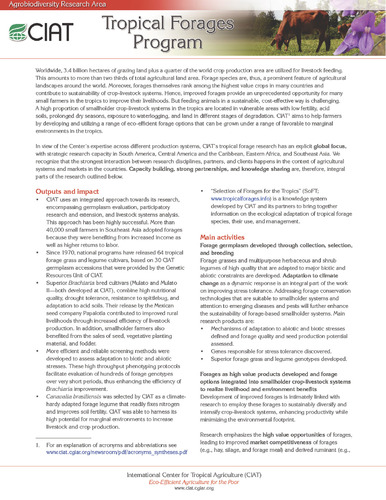Tropical forages program = Programa de forrajes tropicales
Worldwide, 3.4 billion hectares of grazing land plus a quarter of the world crop production area are utilized for livestock feeding. This amounts to more than two thirds of total agricultural land area. Forage species are, thus, a prominent feature of agricultural landscapes around the world. Moreover, forages themselves rank among the highest value crops in many countries and contribute to sustainability of crop-livestock systems. Hence, improved forages provide an unprecedented opportunity for many small farmers in the tropics to improve their livelihoods. But feeding animals in a sustainable, cost-effective way is challenging. A high proportion of smallholder crop-livestock systems in the tropics are located in vulnerable areas with low fertility, acid soils, prolonged dry seasons, exposure to waterlogging, and land in different stages of degradation. CIAT aims to help farmers by developing and utilizing a range of eco-efficient forage options that can be grown under a range of favorable to marginal environments in the tropics. In view of the Center's expertise across different production systems, CIAT's tropical forage research has an explicit global focus, with strategic research capacity in South America, Central America and the Caribbean, Eastern Africa, and Southeast Asia. We recognize that the strongest interaction between research disciplines, partners, and clients happens in the context of agricultural systems and markets in the countries. Capacity building, strong partnerships, and knowledge sharing are, therefore, integral parts of the research outlined below.

